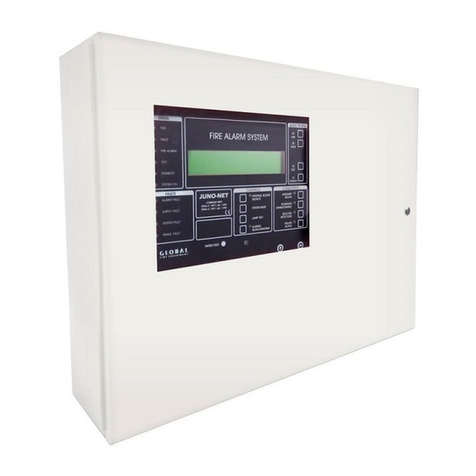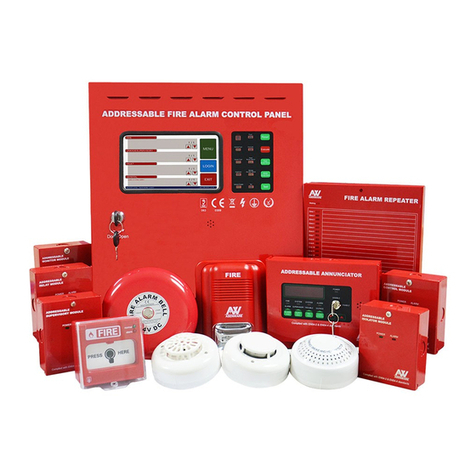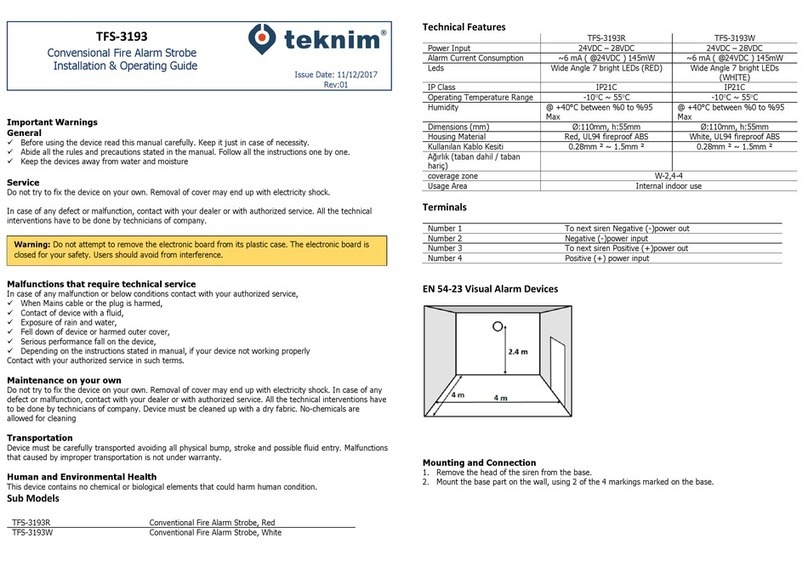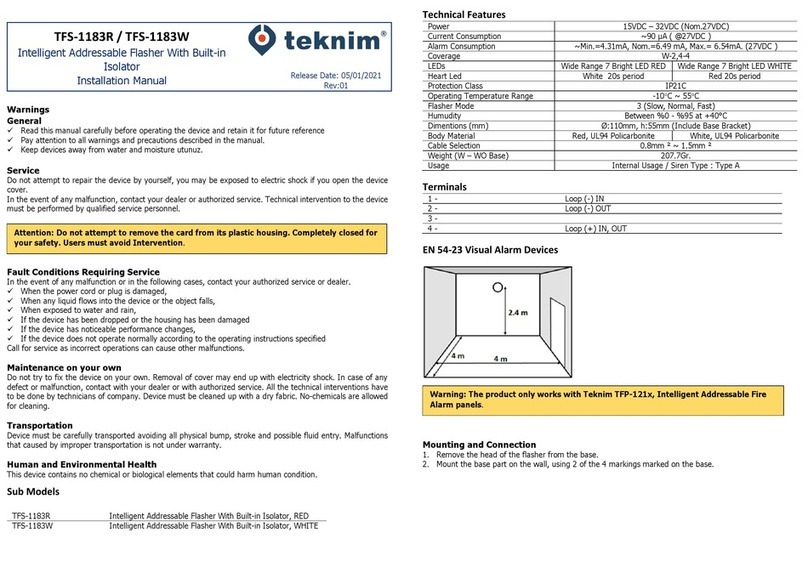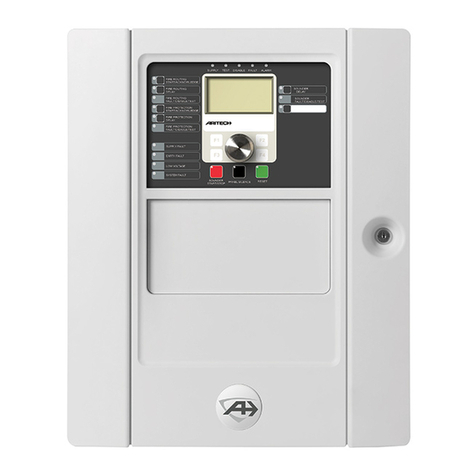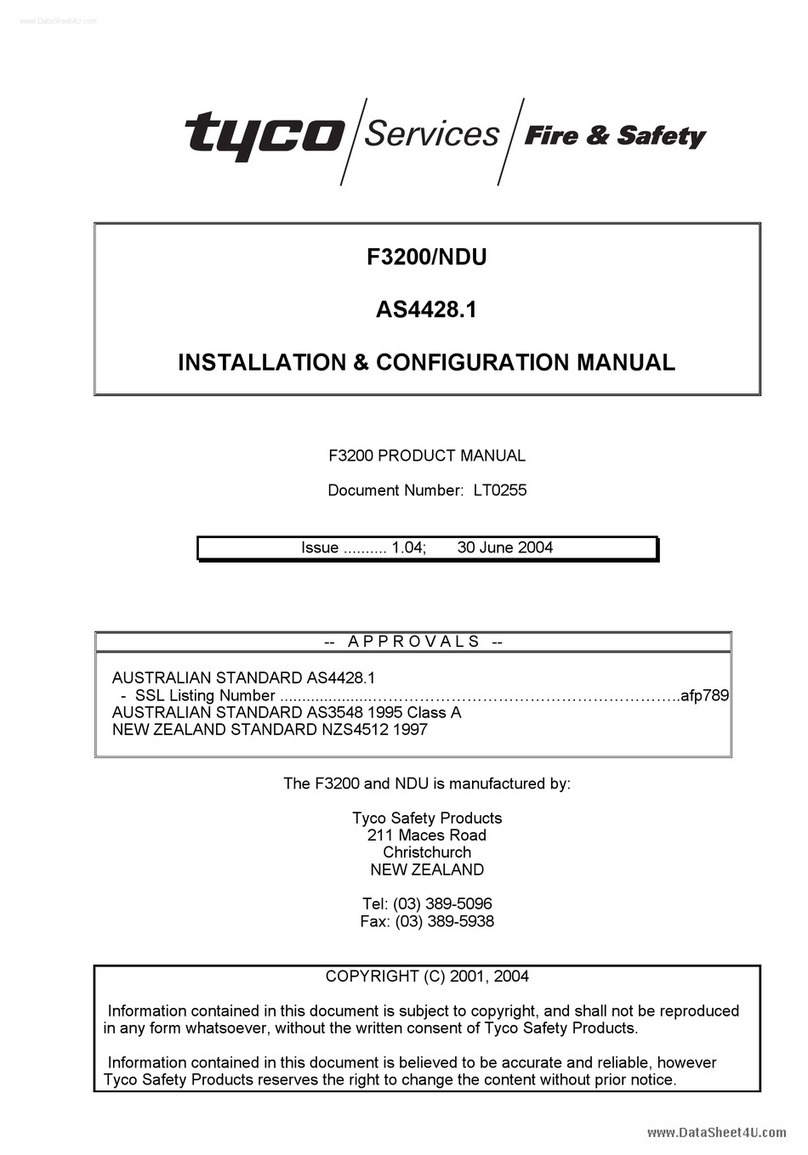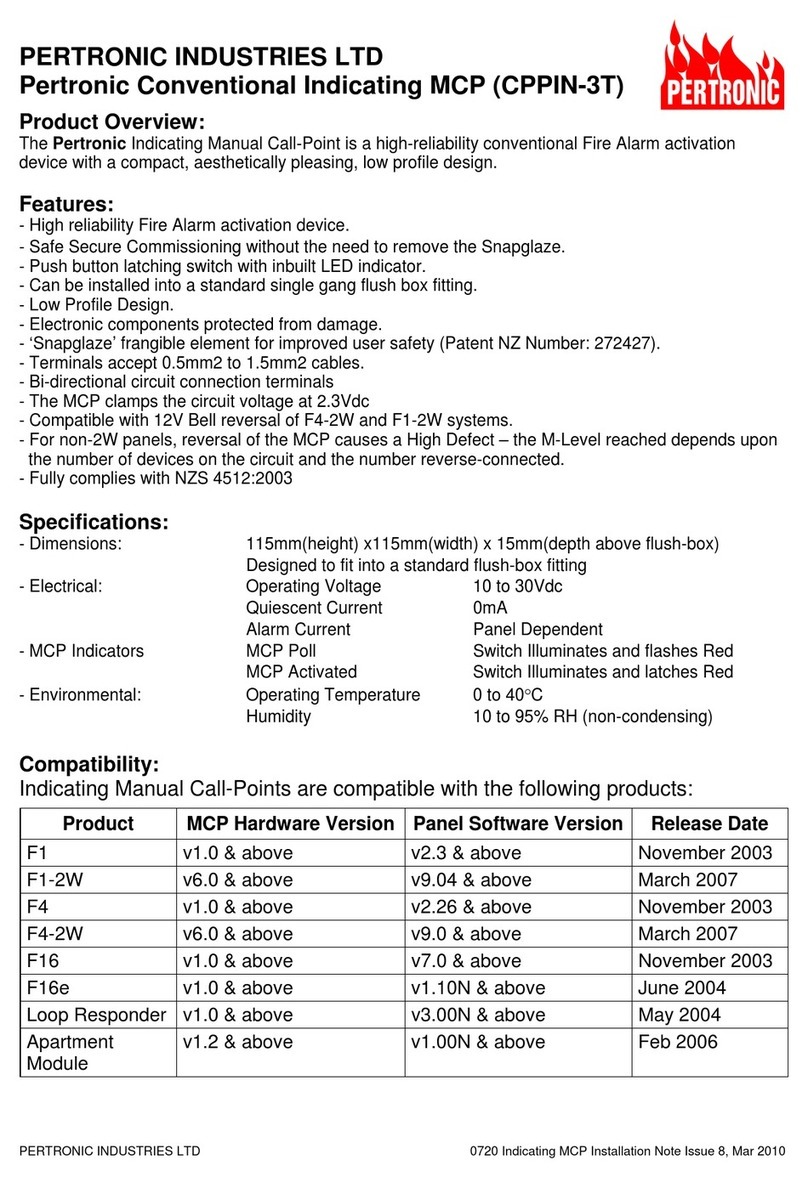Global Fire ORION-EX V2 Owner's manual

Global Fire Equipment // globalfire.pt
ma_oexv2_01_010001_en_180730
ORION-EX V2
Conventional Fire Detection & Extinguishing Panel
INSTALLATION, OPERATION & MAINTENANCE MANUAL
GENERAL DESCRIPTION
The ORION-EX Conventional Fire Detection and Extinguishing Panel is designed and manufactured to comply with
EN54-2, EN54-4 and EN12094-1 standards.
Advanced configuration solutions include the following: programmable pre-release and extinguishing times, electro valve and
flow pressure switch status indications; start and abort remote activation; four fire detection zones causing different effects.
Finally all inputs are fully monitored for both Fire, Activation and Fault Conditions.
MAIN FEATURES
● 4 Fire Detection Zones: 2 crossed Zones and 1 individual Zone linked with automatic extinguishing cycle. One
dedicated Zone only for fire detection which doesn’t start automatic extinguishing cycle
● Up to 32 conventional devices (smoke and/or heat detectors and call-points) per zone
● Active End of Line for Zone wiring monitoring (10uF/50V bipolar capacitor)
● Programmable Pre-Release and Extinguishing times
● Monitored inputs for Manual Extinguishing Cycle Activation and Remote Abort
● Electrovalve solenoid and Weight/Flow/Pressure Switch Status monitoring
● One man test capability
● Supervised auxiliary 24-volt supply output
● 3 Supervised/monitored output circuits
● 1 Remote reset input
● 2 Relay outputs for fire and fault status indication
● Dedicated repeater panel and analogue loop interface
● Additional output via MPX-REL & MPX-SNDR modules
● Fully EN54-2, EN54-4 and EN12094-1 compliant.
IMPORTANT SAFETY NOTES
● This equipment must only be installed and maintained by a suitably qualified and technically competent person.
● This equipment must have an Earth Connection.
● A basic knowledge and training in the installation of Fire and Extinguish Detection systems is assumed.
● The Fire Detection system should be designed by a suitably qualified person with reference to the Local
Regulations and Guidance from the fire Officer where applicable.
1

Global Fire Equipment // globalfire.pt
ma_oexv2_01_010001_en_180730
MECHANICAL DATA
CABLE TYPES
System wiring should be installed in accordance with National Standards and wiring regulations.
To protect against electrical interference, we recommend the use of screened cables throughout the system. Separate
cables should be used for sounder and detection circuits, the use of multi-core cables to carry sounder circuits and detector
circuits is not recommended. The cable screen termination should only be connected to panel Earth points. The maximum
cross section of cables to use is 2.5mm, otherwise terminals in the control panel could be damaged.
Mains wiring should be 3 core 1mm² to 2.5mm² fed from an isolating circuit breaker of 6A. This should be secure from
unauthorized operation and be marked “Fire Alarm Do Not Switch Off”. The mains supply must be exclusive to the fire panel.
CONNECTING THE PANEL
Before connecting zones or sounder cables, power up the control panel with the Active EOL connected to the zone inputs
and the EOL resistors for the sounder/output lines connected. Then connect mains and battery power; there should be no
fault indications. The mains supply should be routed away from the other cables and enter the control panel adjacent to the
mains terminal block.
Depending on panel load and standby requirements, two 12-volt VLRA batteries of capacity up to 7Ah may be fitted in the
housing. The batteries should be wired in series (24V) using the supplied link. Take care not to short circuit the battery
terminals.
Check zones, remote input and outputs wiring for continuity. Short or open circuit indications must be rectified before
connecting to the control panel. All cable testing must be carried out with a Multimeter… NEVER use a Megger when
devices are connected.
Transfer EOL components to the last device on detection zones and sounder/output circuits and connect the cables to their
respective terminals in the control panel. Please refer to info available in next page.
2

Global Fire Equipment // globalfire.pt
ma_oexv2_01_010001_en_180730
DESCRIPTION
EOL
A
Z1, Z2
Crossed Zones (1st: Fire; 2nd: Start Automatic Extinguishing Cycle
CAP
B
Z3F
Fire Zone
CAP
C
Z3X
Extinguishing Zone ( Fire + Automatic Extinguishing Cycle)
CAP
D
EV, PST
Monitored Inputs (Valve solenoid + Pressure/Flow/Weight switch)
CAP
E
INS
Remote Input – Manual Start extinguishing cycle
CAP
F
ABORT
Remote Input – Manual Abort extinguishing cycle
CAP
G
S1
Output Circuit (S1: Active with Fire)
10K
RES
H
S2
EXT - Output Circuit (S2: Active during extinguishing discharge)
10K
RES
I
FIRE REL
REL - Auxiliary Relay – Fire (Changeover)
NA
J
FAULT REL
REL - Auxiliary Relay – Fault (Normally closed)
NA
K
INPUT DE + EV
Not used
NA
L
RST
Remote Reset - Not monitored
NA
M
RM
REM - Monitored Open Collector Output (Active during extinguishing)
4K7
RES
N
AUX
Auxiliary Supply Outputs - 28V DC @ 300 mA
NA
3

Global Fire Equipment // globalfire.pt
ma_oexv2_01_010001_en_180730
PANEL STATUS INDICATORS & CONTROLS
STATUS
FIRE – LED used to indicate any FIRE ALARM condition present on panel.
FAULT – LED used to indicate any Fault condition present on panel. If there is a communication Fault between ORION-EX
and an ORION MINI REP or a Sounder / Relay module, this LED will flash at a rate of once per second.
DISABLED – Disabled Status LED used to indicate that the panel has features that have been disabled.
TEST – This LED is active whenever panel is in TEST MODE, activated in Engineering Mode Access Level 3 only.
SUPPLY - Multi function indicator used to indicate the presence of supply. When in Access Level 1 this
LED is permanently lit. If in Access Level 2 (USER CODE 2244) this LED will flash at a rate of once per second.
If in Access Level 3 mode (ENGINEERING CODE 4321) this LED will flash faster at a rate of once every 0,5 seconds.
SYSTEM FAULT – This LED will be lit whenever there is a processor failure or corruption of the panel firmware.
4

Global Fire Equipment // globalfire.pt
ma_oexv2_01_010001_en_180730
FAULTS
SUPPLY FAULT – This LED will be ON whenever the Main Supply has been removed or has dropped below 20 Volts.
BATTERY FAULT – Indicates that there is low voltage level on the batteries or the battery charger circuit has failed.
SOUNDER FAULT –If there is a conventional sounder circuit fault, the general fault LED will be lit and Sounders LED in the
Faults section will be flashing.
EARTH FAULT – When this indicator is ON, there is leakage current flowing between the Earth connection/wiring and any
other wire connected to the panel.
ZONES & INPUTS
Individual zone and monitored input indicators are provided for both FIRE/ALARM, EXTINGUISH and FAULT conditions. If
any of these inputs is disabled, then its Fault LED will also be used to indicate the disablement of that particular zone/ input.
The zone/ input Disabled LED will be ON along with the associated disabled status LED. Flashing Fault LED along with
general Fault LED indicates fault on that zone.
Zone 3 LEDs provides status indication for both Z3F (for fire detection) and Z3X (for extinguishing and fire detection). Both
Z3F and Z3X share the same status indicators in conjunction.
CONTROL KEYS
These four keys can have more than one function. They are numbered to indicate that they are used to enter digits from 1 to
4 for code entry.
BUZZER SILENCE (1) – At Access Level 1 this button is used to silence the panel's internal buzzer. At Access Level 2 and
3 used to confirm/accept changes in programming. Buzzer must be always silenced before entering the access code to other
levels.
RESET (2) – Press this button to reset the panel at Access Level 2 or 3.
LAMP TEST (3) – Press this button at Access Level 1 or 2 to test all LED indicators and the panel's internal buzzer. Release
when test is finished. At Access Level 3, press this button to enter in “one man” test mode.
SOUNDERS (4) – Press once to activate/silence sounders in Level 2. If sounders are active, for example, during a FIRE
condition or in the event of an Evacuation action, pressing this button will stop the sounders. Auxiliary Relays are not
affected by this action. When selected the disablements in Level 2, this button is used to select the desired disablement. In
Access Level 3, combined with the delay activation button, it is used to select the desired delay.
5

Global Fire Equipment // globalfire.pt
ma_oexv2_01_010001_en_180730
CONTROLS KEYS
Using these keys require Access Level 2.
OUTPUTS – Press this button to enable/ disable an output:
1. When switch is pressed associated LED will also be lit.
2. Select the required output by pressing consecutively the RED BUTTON (4) until the
FAULT LED for the required output is lit.
3. Confirm selection by pressing the GREEN BUTTON (1). The corresponding Red LED will
be lit. Cancel disablement by pressing again the GREEN BUTTON (1). The associated
Red LED will be OFF.
4. To exit function repeat OUTPUTS key press.
The Red LED that is ON indicates which output is disabled.
LED1 (Z1): Disable Aux Relays.
LED2 (Z2): Disable Conventional Fire Sounder Circuit 1.
LED3 (Z3): Disable Conventional Extinguish Circuit 2 and RM Output.
When there are any outputs disabled, the Yellow LED near the output button will be lit.
ZONES – Use this button to disable zones Z1, Z2 and Z3 (F+X):
1. When switch is pressed associated LED will also be lit.
2. Select the required ZONE by pressing consecutively the RED BUTTON (4) until the FAULT LED for the required ZONE
is lit.
3. Confirm selection by pressing the GREEN BUTTON (1). The corresponding Red LED will be lit. Cancel selection by
pressing again the GREEN BUTTON (1). The associated Red LED will be OFF.
4. To exit function repeat ZONES key press.
NOTE: The Z3 will disable both Z3F and Z3X detection circuits.
Disablements Configuration Table
Active LEDS
during setup
ALL LEDS
OFF
Z1
Z2
Z3
EV
PS
REL
EXT
REM
Zones
Disablement
No
Disablement
Zone 1
Zone 2
Zone 3 (F+X)
_
_
_
_
_
Outputs
Disablement
No
Disablement
Relays
(Fire +
Fault)
Sounders
Extinguishing
_
_
_
_
_
After exiting the Outputs Disablement function, if Relays disablement is set, the REL Yellow LED will be ON. If the Sounders
Disablement is set, the SOUNDERS LED on the FAULT Box will be ON. If the Extinguishing Disablement is set, the EXT
and REM Yellow LEDs will be ON. If any of the disablements described above is set, the OUTPUTS LED on the
DISABLEMENTS box will be ON.
6

Global Fire Equipment // globalfire.pt
ma_oexv2_01_010001_en_180730
Disablements LEDs Status Table
Disabled Circuit
Active Yellow LEDs
Zone 1
ZONES + Z1
Zone 2
ZONES + Z2
Zone 3
ZONES + Z3
Relays
OUTPUTS + REL
Extinguishing
OUTPUTS + EXT + REM
Sounders
OUTPUTS + SOUNDERS
KEYS FUNCTION TABLE
Buttons
User
Level 1
Authorized User
Level 2
Engineering User
Level 3
CONTROLS
BUZZER
SILENCE
1
GREEN
insert user
code
Silence
Buzzer
Silence
Buzzer
Confirm Disablement
(Disablements)
Confirm Delay Selection
(see delay config table)
RESET
2
--
insert user
code
--
Reset
Panel
Reset
Panel
LAMP TEST
3
--
insert user
code
Lamp Test
Lamp Test
One Man
Test
SOUNDERS
ACTIVATE/SILE
NCE
4
RED
insert user
code
--
Activate
Sounders
Select
(Disablements)
Select
(see delay config table)
DISABLEMENTS
OUTPUTS
--
Program/Confirm
Output Disablements
--
ZONES
--
Program/Confirm
Zone Disablements
Program/Confirm
Extinguishing Timer
ACTIVATE EXTINGUISHING
--
Turn ON Extinguishing
(5 seconds press)
Program/Confirm
Pré-Release Delay
ABORT
--
Turn OFF Extinguishing
--
7

Global Fire Equipment // globalfire.pt
ma_oexv2_01_010001_en_180730
Connection Diagrams
ZONES 1, 2, 3F & 3X
Four zones are available for detection, each zone has capacity for up to 32 smoke/heat detectors and an unlimited number
of manual call points. This may be restricted by local regulations.
An active end of line capacitor (10UF/50V bipolar) is supplied for each zone, as part of the monitoring circuit. This must be
fitted to the last device of each Zone. If a detection zone is unused, the end of line module must be connected at the panel, if
it’s not fitted, a fault will be indicated for that zone.
A typical detector circuit wiring layout is shown below. Please consult the device manufacturer's instruction manual for
detailed information.
If manual call points are wired on the same circuit as detectors, in order to comply with the requirements of BS5839 with
respect to head removal monitoring, detector bases should have a Schottky diode fitted, which permits manual call points to
continue to operate normally after a detector has been removed (see diagram). Manual call points should have a maximum
internal resistance of (470-680) Ohms in Alarm.
The wiring for each detector zone should be terminated in the relevant terminal blocks at the control panel and the cable
screens connected to earth.
NOTE:
Zone 3F is independent from extinguishing cycle. Upon activation by one detector or call point, only S1 output and
panel fire relay will be activated.
Zone 3X is dedicated for extinguishing cycle activation:
- Upon activation by one detector or call point, both S1 output and both panel fire relay will activate.
- S2 output and REM output will be activated according with the programmed extinguishing cycle.
S1 & S2 MONITORED OUTPUTS
These output/sounder circuits have a combined maximum current output of 1,85 Amps.
Connected devices (sounders, beacons, bells, pyrotechnic actuators, solenoids, relays, etc.) must be polarized,
non-polarized devices trigger a fault on the panel circuit. In order to mitigate this situation a polarization diode should be
added when using bipolar devices. With solenoids, relays and bells a flyback diode should also be present.
An end of line resistor (10K Ohm) which is supplied with the panel, must be inserted in the last device for monitoring. If a
sounder/output circuit is not used, the EOL resistor should be fitted in the respective control panel output.
The sounder circuits are protected against short circuits, the electronic fuse will reset when the short circuit is removed and
the control panel is reset.
8

Global Fire Equipment // globalfire.pt
ma_oexv2_01_010001_en_180730
POLARIZED DEVICES
NON-POLARIZED DEVICES
RELAYS, SOLENOIDS OR BELLS
PYROTECHNIC ACTUATORS
9

Global Fire Equipment // globalfire.pt
ma_oexv2_01_010001_en_180730
RM MONITORED OUTPUT
Monitored open collector output that is active during discharge time.
A 4K7 1/4W resistor should be fitted between the +24 V and the RM pin.
When the EOL is fitted and not active, a value of approx. 20 V should be present on RM.
Output is only suitable to connect an auxiliary relay to activate external actuators such as solenoids. Since it’s an OC output,
output current is limited (<100 mA).
Line monitoring is achieved with a 4K7 resistor that mimics relay coil resistance, therefore resistance should be removed
after connecting relay.
NOTE: Relay must have a 24V DC coil rating.
AUXILIARY INPUTS – Not Monitored
There are on the ORION-EX remote activation inputs. All remote inputs are activated using a voltage free dry contact like a
relay or manual ON-OFF switch between input and ‘C’ terminal.
INPUT EV – Not used. Reserved for future use.
INPUT DE – Not used. Reserved for future use.
INPUT RST – Panel Reset: The closure of a contact at this input will cause the panel to reset. In order to re-apply a reset to
the panel, contact has to be released and reapplied (Pulse action).
10

Global Fire Equipment // globalfire.pt
ma_oexv2_01_010001_en_180730
INPUTS – Monitored
All below inputs require an active EOL to monitor the status of the lines. Faults are signaled via the associated Yellow LED.
Activation of this inputs is accomplished by using a normally open (NO) voltage free contact in series with a resistor with a
value in the range 470 to 1000 Ohms. This is already included in some devices like GFE’s MCPE-C call points. The Red
LED is activated when the contact is closed.
EV – Electrovalve: This input is used to monitor and signal status of the
SOLENOID valve associated with the extinguishing system. This input has no
effect on the panel outputs.
PST – Pressure Switch: This input is used to monitor and signal the status
of the PRESSURE/FLOW SWITCH associated with the extinguishing system.
This input has no effect on the panel outputs.
INS – Extinguishing Immediate Activation: This input starts the configured automatic extinguishing cycle.
ABORT – Immediate Stopping of Extinguishing Cycle: This input stops the extinguishing cycle, normally via a coloured
call point connected directly to input.
OUTPUTS – Monitored
AUXILIARY SUPPLY OUTPUT – 28V DC max 300 mA, short circuit protected, supervised.
The output is protected against short circuit by an electronic fuse which resets when the fault is cleared and
the panel is reset.
RM – Monitored Remote Extinguishing “Open Collector” Output. Maximum current is 100 mA.
OUTPUTS – Non Monitored
FIRE Relay – Provide Fire signal to external devices.
Changeover contact rating: 30V DC / 2 A. Active until Reset.
FLT Relay – Provide normally closed Fault signal to external devices.
Relay contact rating: 30V DC / 2 A. max resistive. Also Active for microprocessor fault. Active until
reset and all faults are cleared. Relay contact will open when any fault is present on the system.
11

Global Fire Equipment // globalfire.pt
ma_oexv2_01_010001_en_180730
OPERATING AND PROGRAMMING THE PANEL
There are three access levels on the ORION-EX:
LEVEL 1 – General User Controls
● Perform LEDs and Buzzer test
● Silence Internal buzzer
● Put the panel into Access Level 2 or 3 using required access codes.
LEVEL 2 – Authorized user controls (2244) or Access Key
This level allows the user to:
● Silence and re/activate S1 sounder output
● Reset after an Alarm or Fault
● Manually activate the sounders (Evacuate function)
● Silence Internal Buzzer
● Disable/Enable: Outputs; Zones & Monitored Inputs; Activate & Abort Extinguishing Cycle.
NOTE: When any zone or function is disabled, the Disabled LED on the STATUS area of the Control
Panel display will be lit together with the corresponding function or zone disablement LED. Disabled
zones will have their corresponding FAULT/DISABLED LED illuminated.
Level 2 Access is gained by entering the code 2244 using the numbered buttons. When in panel is in Level 2 the Green LED
will flash with a frequency of 1 Hz.
Each successful button press is indicated by the illumination in sequence of the top screen Fault LEDs. If the code is not
completed within 20 seconds of the last key press, the system reverts to Level 1.
NOTE: If any Fire or Fault events have occurred these must be acknowledged by pressing the Buzzer
Silence button to acknowledge each Fault or Fire event before code entry will be accepted.
LEVEL 3 – Engineering Functions (4321)
It is accessed from Level 1 and allows:
● One Man Test
● Panel Reset
● Set Extinguishing Pre-Release Delay and Extinguishing Timer.
NOTES:
1) Changes made at this level affect the factory default settings and the operation of the system. They
should only be made by qualified personnel who are fully aware of their effects.
2) If any Fire or Fault events have occurred, these must be acknowledged by pressing the Buzzer
Silence button to acknowledge each fault and Fire event before code entry will be accepted.
3) When in Access Level 3, the occurrence of any Fire or Fault condition the system will automatically
exit from Level 3 and revert to Level 2.
To enter Engineering Mode (Access Level 3) enter the code 4321, using the numbered keys (from 1 to 4), which are
available on the top right-hand side of the control panel display. Each successful button press is indicated by the illumination
in sequence of the Fault LEDs for zones 3, 4, 5 and 6. If the code is not completed within 20 seconds of the last key press,
the system reverts to Level 1.
Once this mode is entered the Green LED (SUPPLY) will flash once every 0,5 seconds.
To exit this mode at any time, press the RESET button. The panel will revert to Access Level 1.
Total removal of power during the programming phase could cause changes not to be saved.
12

Global Fire Equipment // globalfire.pt
ma_oexv2_01_010001_en_180730
COMMISSIONING
The ORION-EX is supplied ready to operate as a standard conventional Fire Alarm control panel. Additional function
programming is described in the next section.
The default settings for the ORION-EX are as follows:
● All zones Latching.
● Immediate extinguishing/discharge activation (no pre-release delay and discharge activated until Reset).
● Authorized User Access Code (Level 2): 2244.
● Alternatively, access to Level 2 can be entered using the Physical Access Key provided.
● Engineering Access Code (Level 3): 4321.
PREPARATION
1º. Check detector cables and ensure all field connections are made, ensure that all EOL devices are fitted to the last
detector, call point or sounder of each circuit. EOL Capacitors should be fitted to zones or remote monitored inputs.
EOL Resistors should be applied to sounder/output circuits.
2º. Remove the mains fuse.
3º. Connect mains supply according to local mains voltage. Ensure good earth connection.
4º. Fit batteries (Do not connect).
5º. Insert mains fuse and connect batteries - Observe correct polarity.
COMMISSIONING
1º. If all is normal only the Green “supply” LED should be illuminated.
2º. If any Faults are indicated, they should be corrected before proceeding.
3º. Initiate lamp test and check LEDs and internal buzzer operation..
4º. Test each key for correct functioning.
5º. Test all detectors, manual call points, sounders, relays etc. for proper operation.
TESTING ZONES – Z1 to Z3
1º. Set zones to Test mode with level 3 access.
2º. Press LAMP TEST key.
3º. Activate device according to manufacturer specification.
4º. Wait until response indicator on device indicates Red.
5º. Reset initiating devices or until detectors are normal (Z1 to Z3).
6º. Automatic reset after (10 sec).
After testing is completed be sure to return control panel to normal operating mode. Pressing RESET
button will EXIT TEST mode.
TESTING – S1 Output Circuit
1º. Initiate sounder test by entering Access Level 2 and pressing SOUNDERS ACTIVATE/SILENCE.
2º. Press again to Stop.
TESTING – FIRE, FLT, S2, RM Outputs
With the system in normal operating mode induce an Alarm and a Fault to confirm proper operation of relays and external
devices at the end of any programmed delay. For S2 and RM testing, induce an alarm over Z3X or on both Z1 & Z2 in order
to trigger an extinguishing cycle.
13

Global Fire Equipment // globalfire.pt
ma_oexv2_01_010001_en_180730
PROGRAMMABLE OPTIONS
The ORION-EX has a number of programmable options to help the engineer customize the system to meet the customer's
requirements. To access these options it is necessary to enter Access Level 3.
ONE MAN TEST
After entering Engineering Mode (Access Level 3) press the LAMP TEST button. Release button and the TEST LED will be
on along with the fault LED for all zones that are available for testing indicating that the panel is in TEST mode.
Zones that are in Fault or are Disabled will not have their LED illuminated.
Test the zones accordingly with installation requirements. At each zone activation, the corresponding zone FIRE LED will
light up for 5 seconds.
Zones will automatically reset after 10 seconds. Internal Buzzer and SOUNDERS will operate for 1 second.
To end TEST mode press LAMP TEST button.
To exit Engineering Mode (Access Level 3), press the RESET button.
PRE-RELEASE DELAY
1. After accessing Level 3, press ACTIVATE EXTINGUISHING switch. The associated LED will be activated.
2. Select the required time delay by pressing the Red switch (4) consecutively until one of the LEDs that correspond to
required day it’s lit up. Please refer to below table for additional details.
3. Confirm the selection by pressing GREEN (1) key. Upon confirmation the Red (FIRE) LED will be activated. Remove
selection by pressing the GREEN key again. The corresponding LED will be switched OFF.
4. To exit the function press ACTIVATE EXTINGUISHING switch.
When accessing Pre-Release delay configuration mode, if a delay was already programed, the Red LED associated with the
programmed delay will be shown.
EXTINGUISHING TIMER
1. After accessing Level 3, press ZONES switch. The associated LED will be activated.
2. Select the required time delay by pressing the Red switch (4) consecutively until one of the LEDs that correspond to
required time it’s lit up. Please refer to below table for additional details.
3. Confirm the selection by pressing GREEN (1) key. Upon confirmation the Red (FIRE) LED will be activated. Remove
selection by pressing the GREEN key again. The corresponding LED will be switched OFF.
4. To exit the function press ZONES switch.
When accessing Extinguishing Timer configuration mode, if a delay was already programed, the Red LED associated with
the programmed delay will be shown.
Delay Configuration Table
Active LEDs
during setup
ALL LEDS
OFF
Z1
Z2
Z3
EV
PS
REL
EXT
REM
Corresponding
Delay in seconds
Immediate
(Pre-release)
Active until Reset
(Extinguishing)
15
30
45
60
90
120
150
180
14

Global Fire Equipment // globalfire.pt
ma_oexv2_01_010001_en_180730
EXTINGUISHING CYCLE - AUTOMATIC
GRAPHICAL OVERVIEW
Z1 & Z2:
ZONES
Z1
ON
OFF
Z2
ON
OFF
OUTPUTS
S1
ON
OFF
S2
ON
OFF
RM
ON
OFF
DELAYS/
TIMERS
PRE-RELEASE
ON
OFF
RELEASE
ON
OFF
Z3X:
ZONES
Z3F
Z3X
ON
OFF
OUTPUTS
S1
ON
OFF
S2
ON
OFF
RM
ON
OFF
DELAYS/
TIMERS
PRE-RELEASE
ON
OFF
RELEASE
ON
OFF
NOTE: All outputs are deactivated with panel RESET.
15

Global Fire Equipment // globalfire.pt
ma_oexv2_01_010001_en_180730
FUNCTIONAL DESCRIPTION
Based on presented in graphical timeline, when both zones 1 and 2 are in Fire condition, the pre-extinguishing delay is
initiated, if previously programmed. Also if zone 3X is activated the pre-extinguishing delay is also initiated, if previously
programmed.
●S1 output is activated immediately with each zone activation (including Z3F an Z3X).
●S2 and RM outputs will be active for the duration of the programmed time but only after the pre-extinguishing delay
has elapsed (after Z1 & Z2 or Z3X).
●S1 output can be silenced using Sound/ Resound Alarms button.
NOTE: If no extinguishing delay has been programmed (default), S2 output and output RM will
activate immediately for the duration of the programmed extinguishing cycle (default condition is
activation until panel reset).
When this timer elapses, both S2 and RM outputs will be deactivated (if programmed to do so).
Sounder Circuit 1 is silenced using Sound / Resound Alarms button upon entering access level 2. After Sounder Circuit 1 is
silenced, the LED associated with the Sound / Resound Alarms button will be OFF.
FIRE LEDs for zone 1 and 2 will be active. With each fire activation the Sounders Red LED is activated.
When the extinguishing discharge is active, both EXTINGUISHING and REMOTE O/P Red LEDs will be lit.
EXTINGUISHING CYCLE - MANUAL
MANUAL – INS Input
Upon activation of this input, normally via a dedicated coloured call point, extinguishing cycle process starts in the same way
as if both zones Z1 & Z2 or Z3X have been activated.
●S1 output is activated immediately. S1 output can be silenced using SOUNDERS ACTIVATE/SILENCE button.
●S2 and RM outputs will be active for the duration of the programmed time but only after the pre-extinguishing delay
has elapsed.
MANUAL – Panel
The extinguishing process can be controlled manually using the buttons available on the panel’s front display.
16

Global Fire Equipment // globalfire.pt
ma_oexv2_01_010001_en_180730
The extinguishing discharge can be initiated manually executing the following steps:
a) In Level 1, silence the internal buzzer using the Internal BUZZER SILENCE button if there are any Fire or Fault conditions
which have not been acknowledged.
b) If panel is in Access Level 1, Access Level 2 by using either the access key provided or by user code 2244.
c) In order to activate the extinguishing press the ACTIVATE EXTINGUISHING button for at least 5 seconds.
● Activation is confirmed after the internal buzzer sounds for 1 second.
● Extinguishing outputs RM and S2 will be activated for the duration of programmed extinguishing time.
● S1 will also be activated.
NOTE: The pre-release delay is not activated! Discharge is initiated immediately.
TROUBLESHOOTING - FAULT INDICATIONS
NOTE: Troubleshooting of any fault on the panel should only be carried out by qualified technicians.
General Fault - The General fault LED is illuminated whenever there is a fault on the system. It is always lit along with at
least one other fault indicator which gives more detail relating to the fault.
Zone Fault - This type of fault will indicate that there is either a short or open circuit condition on zone circuit. Revise wiring.
Supply Fault - Associated with a low voltage (below 20 V) present at the input of the power supply or the removal of the
main power supply. Measure voltage levels and verify electrical mains fuse.
Battery Fault - This fault is present when there is a low voltage below 20V DC at the battery terminals or if there is a battery
charger problem. Charger problems can be caused by panel's hardware failure or batteries that have not been connected in
the specified manner as indicated in this manual, on the installation section. Verify if batteries are properly connected.
Measure the voltage at the battery terminals. If it is below 21V DC replace batteries. Remember to verify also the main
electrical fuse.
NOTE: Don’t short circuit battery terminals in order to verify battery charge. Only use batteries which
are batteries which are VLRA LEAD ACID 12V DC.
Earth Fault - This FAULT will indicate that there is some level of current leakage between any of the wire conductors and
the EARTH connections. For additional info please check website FAQ Fault Finding section.
System Fault - This FAULT indicates that there is a fault at the main processor level. In this particular fault, the panel's main
board needs to be replaced or repaired.
17

Global Fire Equipment // globalfire.pt
ma_oexv2_01_010001_en_180730
STANDBY BATTERY CALCULATION
Battery capacity should be between 2 x 2.4 Ah 12V DC and 2 x 7 Ah 12V DC.
The battery Ah required for a given installation is calculated from the following formula:
(
Quiescent current in
mA of the panel with
everything
connected
X
Standby time
required in
hours
divided by
1000
)
+
(
Alarm
current in
Amps
(sounder
load)
X
Alarm
time in
hours
)
+
20%
Round the result to the next available battery size. Quiescent current of the panel with everything is found by adding the
standby current of all connected devices to the standby current of the panel (38 mA). Consult the manual for the individual
devices to confirm the standby current.
Repeater Interface Connection
The interface board used to establish communication between the ORION-EX and its associated repeater(s) should be
linked to the connector labelled DATA, which is situated on the underside of the panel’s main board. The interface should be
fixed to the base of the back box as shown before. The panel’s main board and interface are connected using the 5-way flat
cable provided. The cable is fitted with 2 polarized connectors of the Molex type.
For details about connection, please refer to repeater installation manual.
Modules Interface Connection
The ORION-EX and its associated modules should be linked to the connector labelled MPX, which is situated on the
underside of the panel’s PCB board. The module should be fixed to the base of the back box as shown before. The panel’s
main board and module are connected using direct 5-way flat cable provided. The cable is fitted with 2 polarized connectors
of the Molex type.
The following modules can be connected:
●GFE-MPX-REL V2 for Relay activation extension
●GFE-MPX-SNDR V2 for Sounder activations (Z1, Z2, Z3F, Z3X, etc)
●ADLI V2 if a connection to a GFE Addressable panel is needed (DATA connector)
GFE-MPX-SNDR V2 and GFE-MPX-REL V2 outputs will activate upon the ORION-EX panel actions shown in the table
below.
ORION-EX
Z1
ALARM
Z2
ALARM
Z3F
ALARM
Z3X
ALARM
S1
Pre
Release
RM
RM
GFE-MPX-SNDR V2
/ GFE-MPX-REL V2
OUTPUTS
S1 /
REL1
S2 /
REL2
S3 / REL3
S4 / REL4
S5 / REL5
S6 / REL6
(latching)
S7 / REL7
S8 / REL8
For details about connection, please refer to specific module installation manual or contact authorized GFE distributor.
18

Global Fire Equipment // globalfire.pt
ma_oexv2_01_010001_en_180730
Connection diagram of ancillary Modules (only compatible with V2 versions)
5-way flat cable from MPX, 5-way connector on underside of
ORION EX V2 main board to MPX 5-way connection on
GFE-MPX-SNDR-V2 or GFE-MPX-REL-V2 board
ORION EX V2 GFE-MPX-SNDR-V2
or GFE-MPX-REL-V2
Connection to “ORION-EX Mini Repeater V2” or ADLI V2 Module
ORION EX RS232/485 Interface
or ADLI V2 board
5-way flat cable from DATA 5-way connector
on underside of Orion EX V2 main boards to DATA 5-way
connector on RS232/485 or ADLI V2 board
19

Global Fire Equipment // globalfire.pt
ma_oexv2_01_010001_en_180730
TECHNICAL SPECIFICATIONS
TECHNICAL SPECIFICATIONS
PRIMARY SUPPLY VOLTAGE - IN
230 +10% -15% V AC
PRIMARY SUPPLY VOLTAGE- OUT
28.5V DC nominal
PRIMARY SUPPLY CURRENT-OUT
1.7 A @ 28.5V DC nominal (max.)
SECONDARY SUPPLY VOLTAGE
21.0 min. - 27.2 max. V DC - BAT charger o/p 28V DC
SECONDARY SUPPLY CURRENT OUTPUT
1.85 Amp maximum @ 20oC
INTERNAL BATTERY CAPACITY - MAXIMUM
2 x 12V x 7Ah Sealed VRLA Lead Acid Batteries
MAINS FUSE
4 A -250 V Slow Blow - 20 mm
BATTERY FUSE
1.85 Amp - Resettable
NUMBER OF DETECTION ZONES
4
ZONE CURRENT - QUIESCENT / ALARM
10 mA / 60 mA maximum
MAX. CABLE RESISTANCE / CAPACITANCE
40 Ohms / 0.470 uF
END OF LINE MONITORING
Active EOL - 10uF/50V Bipolar Capacitor
BS5839 DETECTOR REMOVAL COMPLIANT
YES provided diodes are fitted to detector base
DEVICES PER ZONE
32 maximum - EN54 pt.2
ALARM RESISTANCE VALUE: INPUTS
270 - 1000 Ohms
MAXIMUM CURRENT: OUTPUTS
1,85A maximum current drive for both S1 & S2 circuits; 100mA for RM output
VOLTAGE OUTPUT
27.5V DC nominal
END OF LINE RESISTOR: S1 & S2; RM
S1 & S2: 10K Ohms - 1/4 Watt; RM: 4K7 Ohms - 1/4 Wat
AUXILIARY RELAY OUTPUT
1 Fire (COM-NC-NO) - 1 Fault (COM-NC) non-supervised
RELAY CONTACT RATING
30V DC - 2 Amp resistive loads
FULLY MONITORED INPUTS
Remote Activation, Remote Abort, Solenoid Status, Flow/Pressure Switch Status
EVACUATION AND RESET
Non-Latching - Voltage free contact
MAXIMUM HUMIDITY
95% RH Non-Condensing
PROTECTION RATING
IP30
OPERATING TEMPERATURE
-10ºC to 50ºC
WEIGHT
1.7 Kg - 7 Kg (inc. 2 x 7 AH 12 V bat.)
DIMENSIONS
273 (L) x 107 (W) x 404 (H) mm
COLOUR
White or Red
20
Table of contents
Other Global Fire Fire Alarm manuals
Popular Fire Alarm manuals by other brands
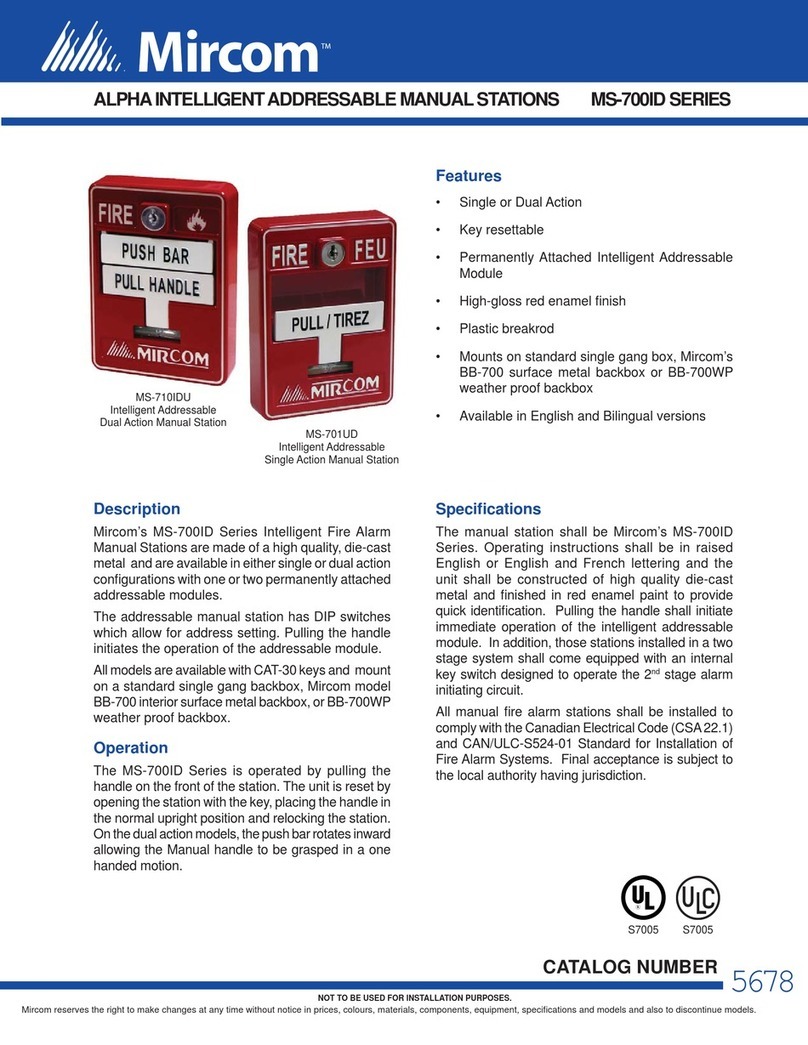
Mircom
Mircom MS-700ID SERIES operating instructions

Wheelock
Wheelock NS4-2415W installation instructions
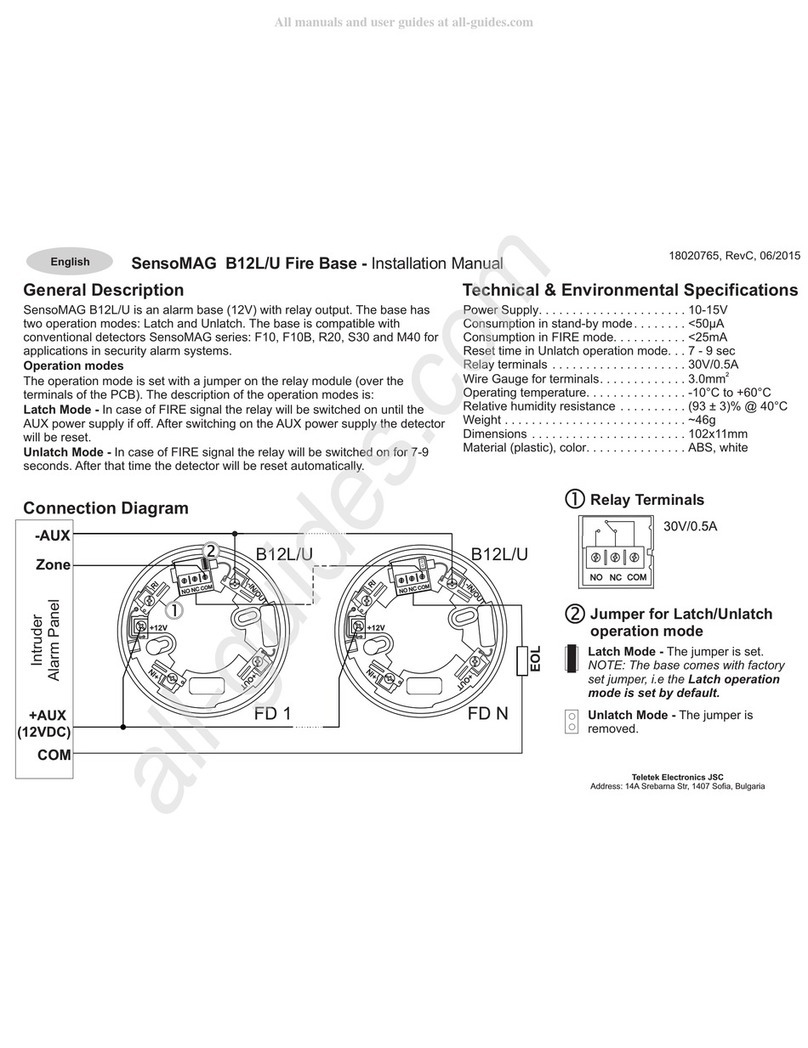
Teletek electronics
Teletek electronics SensoMAG B12L/U installation manual

Honeywell
Honeywell Silent Knight SK318PT Installation and operation guide
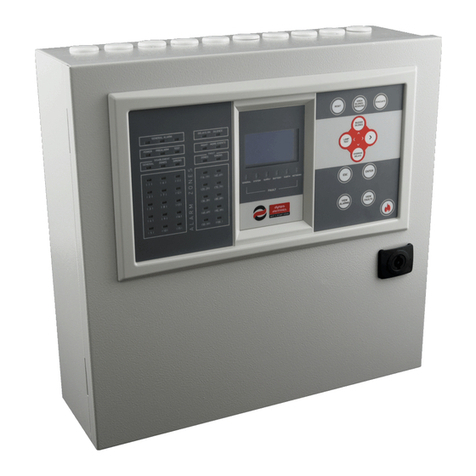
olympia electronics
olympia electronics BSR-100 Series Quick Installation Guide & Generic Design
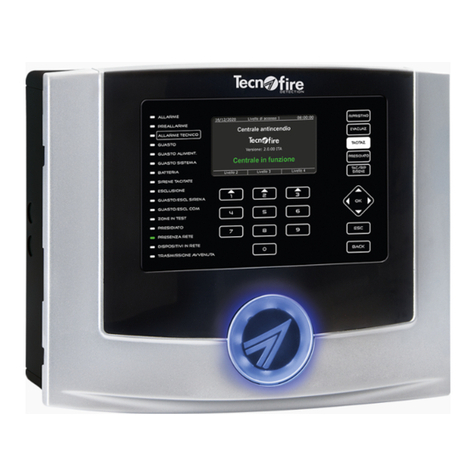
Tecnoalarm
Tecnoalarm Tecnofire TFA2-596 Installation

